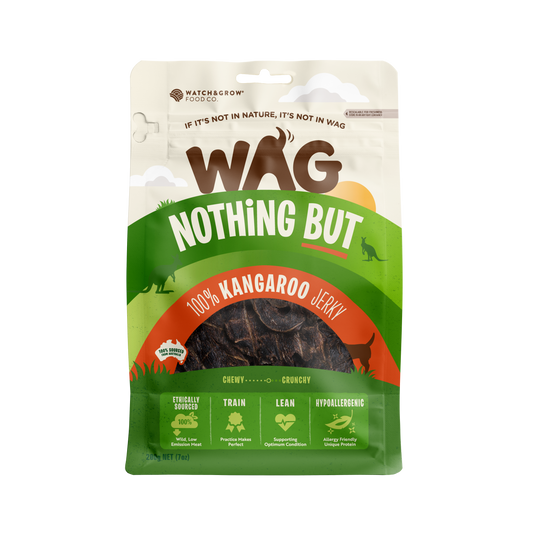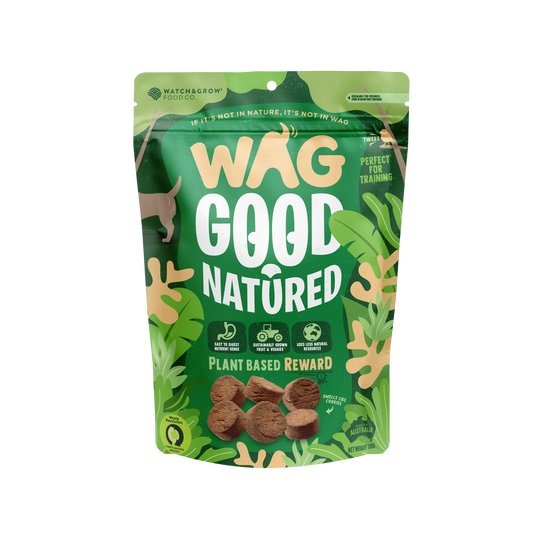As pet parents, we all want the best for our dogs - and that includes having a well-rounded doggo. Training is important for all dogs, big or small, puppies or senior citizens.
It's important that dog owners understand which training methods are most effective when it comes to training their dog, while also training humanely and with the dog's best interest at heart.
Positive reinforcement dog training is not only highly effective in encouraging the desired behaviour, but it's also gentle and best for dog welfare.
Positive reinforcement dog training doesn't need to be overwhelming. Let's take a look at using positive reinforcement for training pet dogs.
What is positive reinforcement dog training?
Positive reinforcement training for dogs is a principle of operant conditioning. Positive reinforcement is used to reward the dog for desired behaviours, which increases the chance of the dog repeating that behaviour in the future. This reward may be a treat, verbal praise, a toy, pats or something similar that your dog finds rewarding.
Positive reinforcement rewards good behaviour (such as following verbal cues like sitting on command) and ignores negative behaviours (such as barking). An aspect of operant conditioning which aims to reinforce the desired behaviour, dogs respond well to positive reinforcement. They learn that they receive a reward when they exhibit a particular behaviour or do a certain trick. This will encourage them to continue doing that thing. Nobody is more motivated by a reward (particularly food rewards) than a dog!
Positive training methods are a great way to foster a healthy relationship between the dog and their owner. Positive reinforcement training doesn’t rely on intimidation or fear, and instead gives a dog opportunities to be rewarded by their human. Dogs love knowing they’ve pleased their owner!

Positive reinforcement dog training examples
Each pooch is different. For training, the reward you offer should be enticing and irresistible to your furry friend, and that may vary for different dogs.
Some ideas of rewards for training include:
- Food. This is probably the most obvious - most dogs are motivated by their stomach! Get some good quality natural treats such as beef jerky dog treats and your pup will be learning new things in no time.
- Verbal praise. A doggo loves knowing when they've pleased their human. Make a big deal out of them when they perform the behaviour you're trying to teach. Dogs respond well to a positive tone of voice. Over time as your dog learns the new behaviour, you can slowly reduce the verbal praise down to a simple (but still positive) phrase such as 'good boy/girl!'.
- Toys. Make sure you select a toy that is the most exciting to your dog (toys that squeak are often the way to go!). To reward your dog during training, give them the toy to play with for a few minutes. At the end of the training session, put the toys away so they maintain their excitement next time.
- Pats. If you've got a particularly cuddly dog on your hands, physical affection is a great way to reward them during training.

A note on food treats for dogs
Not all dogs are motivated by food, it's true. But before you assume your dog isn't food-motivated and dismiss using treats for training, make sure you check what sort of treats you're offering.
Not all dog treats are created equal. Shop for a natural dog treat without preservatives, fillers or nasties. Commercial dog treats that have an ingredient list a mile long can have a negative impact on your dog's health.
Food rewards should be small to be consumed quickly so that training can continue. Treats such as bully bites or forage fish are perfect for reward-based training, as they're full of nutrients for your dog's wellbeing, and will be gobbled up quickly so you can get back to training. You can always end the training session with a longer-lasting treat such as a goat horn if you feel your dog deserves it (and they definitely do!).
Ensure you shop from a business you can trust. Here at WAG, we work closely with local farmers to ensure our products are both ethical and sustainable. This way you can rest assured knowing the food rewards you offer your doggo during training sessions are natural, ethically sourced, gentle on the environment.

Why do we want to avoid punishment and aversive training methods?
Aversive training methods use intimidation, fear or pain as punishment for undesired behaviours. Whereas with positive reinforcement we want to encourage good behaviour, the idea behind aversive training methods is to punish unwanted behaviour.
Training dogs with aversive dog training methods uses 'positive punishment' or 'negative reinforcement' in order to change a dog's behaviour.
Aversive techniques used by some dog trainers may include a shock collar, choke collar, yelling, hitting, or sharp pulling on the lead, to name a few.
Aversive techniques can have a negative impact on the mental and physical wellbeing of your dog. Not only is the use of aversive stimuli a bad idea for animal welfare, it's also simply not as effective as reward-based training.
Negative punishment aims to stop 'bad things' your dog is doing - but it doesn't show them what action is desirable. Negative punishment involves taking away something that is enjoyed by your dog, and often the dog won't know what they're being punished for.
Long term, this style of training may have a lasting psychological impact on the dog, and they may become skittish and timid, and/or aggressive.
Rewarding the good things
Positive reinforcement is not only one of the most effective dog training methods, but it is also the best in regards to dog welfare. Positive reinforcement allows a dog to learn in a way that makes them feel safe and supported, rather than using punishment which can have a negative impact on not only a dog's ability to learn, but also their overall wellbeing, and the relationship they have with their owner.
If your furry friend is motivated by tasty treats (and, let's face it, most of them are!) make sure you buy natural treats from a sustainable and ethical business to help support your pups wellbeing. Check out our range of WAG high quality natural dog treats online today, or shop a select range in-store at all major pet specialty stores or in Coles and Woolworths now.
Try This
WAG Team
Up Next
How to House Train a Dog: A Fun and Stress-Free Guide for New Dog Parents





